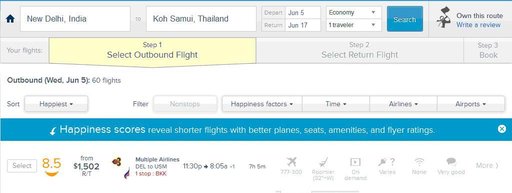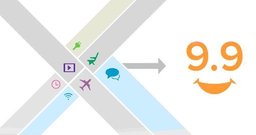When big data meets flight meta-search it’s happy routing for passengers
Data is promising to be a real differentiator for new travel intermediaries. The meta-search site is one category that is trying to become more meaningful on the basis of data sources. As a new entrant, Routehappy believes its data is not only the key to consumer loyalty, but improved conversions too. EyeforTravel’s Ritesh Gupta talks to the site’s founder and chief executive, Robert Albert.
Travel meta-search sites are increasingly able to interpret what a traveller is thinking and find ways to differentiate between flights in a more human way. This is in their interests. After all as airline distribution evolves, many players are looking to highlight the amenities and services air passengers care about most in order to differentiate. This ability to be more than just any other search engines is a welcome change from what has become a somewhat commoditised experience. Rather than producing straightforward results, companies are now able to connect users with what they expect or even delight them with what they didn’t expect, thus lending a new dimension to search.
The experience matters
Flight search today is predominantly based on price and schedule which forces consumers to choose flights based on the lowest prices. “This is problematic for the airlines and consumers,” says Robert Albert, founder and chief executive, Routehappy, a new meta-search site that launched in April.
Consumers have been trained to treat flights as a commodity and are unable to choose flights based on the experiential factors that matter most - factors like seat comfort, entertainment, and WiFi. That’s where Routehappy steps in.

“Commodity based flight search blocks airlines from differentiating their products from competitors. What’s more troubling is that the airlines are spending billions of dollars upgrading amenities and services and purchasing new aircraft, plus refurbishing older planes. But until Routehappy, no travel site - not even the airlines - exposed this data in search results so flyers can find the best planes with the comfiest seats and most amenities,” says Albert.
The site’s mission is to help people fly happier for less. To do so, the team has built a new breed of meta-search site to expose the experiential factors flyers care about most such as seat size (pitch and width), Wi-Fi, and entertainment. “For the first time, a travel site is allowing flyers to compare comfort alongside price and schedules,” says Albert.
Delving into data
The team at Routehappy spent well over a year combining manual and engineering work with a team of airline and data experts. With a combined 50 years of travel experience, the group’s data team manually gathers complex information about flights from hundreds of sources including an airline’s website, airline press releases, airline staff, industry analyst, industry influencers, blogs, forums, news stories and the Routehappy community of real travellers.
Data is fed into Flightpad, a proprietary database system built by Routehappy that scores product attributes and matches them with dynamic flight availability. Routehappy’s VP of Data (co-founder Adam Gwosdof) built an algorithm that ranks flights based on the Happiness Factors flyers care about most: including nicer planes, roomier seats, best entertainment, in-seat power, WiFi, trip duration, on-time record, and higher flyer ratings.

Finding the right experience
For the comfort of travellers, Routehappy has worked on one-of-a-kind Happiness Scores. This way it reveals shorter flights with better planes, seats, amenities and flyer ratings. Its system grades a myriad of Happiness Factors that matter to flyers, including 25 seat types, 20 entertainment options, 55 seat configurations, WiFi and so on.
The site ranks billions of flights and connections worldwide, which are matched with a low fare search engine. Scores and prices are presented side-by-side for a fresh new approach to flight search.
Real world examples:
· LA to Miami: American Airlines has 9 non-stop flights. Two have much better economy seats than the other seven. Three have WiFi for sure. Four have the old kind of overhead entertainment (while the others have more modern kinds, either in-seat or streaming to your own device.) Flyers can easily pick a flight that more fully meets their individual needs with this information.
· Dubai to Bangkok: Emirates has four non-stop flights. Only one has the best kind of business class seat, a full flat pod. The other three have angled flat seats. Business class passengers on Emirates are often surprised when they get one of the older seats, and now they have the information to pick the newest and best options.
· New York to Phoenix: US Airways currently has seven non-stop flights a day. Three of them have an inch more legroom than the others in standard Economy seats and also offer WiFi while the other flights have less legroom and only might have WiFi. These flights are almost always priced the same, so a little bit of knowledge can make a huge difference to a flyer’s comfort and productivity.
The team at Routehappy believes that the site is uniquely poised to attract a loyal, highly qualified consumer who cares about their experience. “We think this consumer will come to Routehappy ready to buy, and often times willing to pay more for a better experience,” says Albert.
The next big thing is moving beyond a simple focus on price. “You wouldn’t just buy a computer based on what's cheapest, or Apple would never sell a laptop,” says Albert, who believes travel is evolving to something similar. “There’s a big data problem out there to be solved, but the solution needs a mix of powerful systems and knowledgeable human beings who can apply their expertise and make sure that the analytics and the algorithms are accurate.”
Generating revenue
Albert acknowledges that revenue generated from air search alone will not sustain a business. So sites like Routehappy need to carve out additional revenue generators.
Routehappy’s value proposition gives it more revenue options than commodity-based flight search sites. Airlines know flyers care about aspects of the experience beyond just price.
“We’re developing unique targeting capabilities for airlines and others to upsell their products, which is an entirely different economic discussion from selling a low-fare ticket with airlines. We also have shopping and purchase analytics that are valuable to the industry,” says Albert.
Finally, most meta-search sites are lean, especially compared to OTAs. “Routehappy is especially lean. We know how to stretch every dollar until we get the business off the ground. And we don’t need a 50-person team. Look what we’ve done with eight people,” says Albert.
As far as the product development is concerned, there’s an important line to be drawn between providing all kinds of travellers with the powerful search options that they need and yet not overwhelming them with check-boxes and text fields. For its part, Routehappy uses a very clear combination of free text entry, smart city system and robust sorting or filtering options to guide passengers to finding the best flight for their personal needs and priorities.

